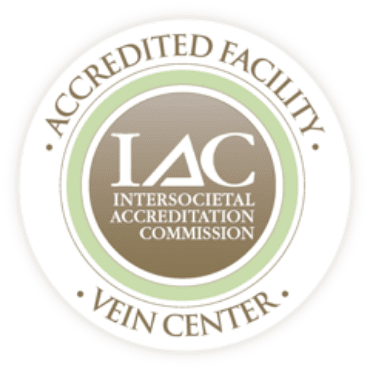When Orthopedic and Venous Disease Collide.
“Orthovenous” disease you ask? What is that? Is that even a disease or a word? Well…not exactly, but it is a neologism I have created to describe a much more common entity I have encountered in my vein focused practice. Patients with orthopedic disease are of the age group that has a high prevalence of venous insufficiency (varicose veins and other presentations of vein disease). To help illustrate my point I would like to use an actual clinical case. Fran, an active medical office manager for her husband’s OB-GYN practice, decided to retire near the Gulf waters in Cape Coral. Happy in her Florida home, Fran, 68, immediately became involved in her community. As she stayed busy with all of her activities, her knee began to swell and ache. It was getting progressively worse until it began interfering with some of the things she enjoyed doing.
“I was having terrific pain in my right knee, the lateral side of the right knee,” she describes. “I also had a pronounced lump in the back of the knee, and I was very uncomfortable. The pain was excruciating. I couldn’t even drive a car for any distance because I would have to keep stopping to get out and walk. I couldn’t climb up a flight of stairs. I couldn’t exercise. It really stopped all activities for me.”
After consulting an orthopedic surgeon and podiatrist about the pain, a vein evaluation was suggested and she was referred to Vein Specialists. Fran was shocked by what Dr. Magnant’s evaluation uncovered.
“They did an ultrasound of the leg and found severe leakiness in the check valves in the main superficial vein (great saphenous vein)” reports Fran. “I had a leaking vein from the groin area all the way down the leg. After a successful trial of compression hose (some of the pain was relieved with hose) endovenous ablation (heated sealing of the affected vein from within) was performed on Fran’s great saphenous vein under local anesthesia and her response was remarkable, with near immediate resolution of most of her leg discomfort.
So what exactly is meant by the term “Orthovenous Disease”?
Many patients I have evaluated over the past 15 years for all stages of venous insufficiency whether it be large varicose veins, swollen and discolored legs or symptoms of leg fatigue, heaviness or cramps often have had total knee replacement incisions over their knees or have arthritic appearing knees. Thus I coined the term “Orthovenous” disease. Knee and hip joint arthritis and venous insufficiency often coexist because they affect the same age patient population, patients over the age of 40. Therefore, patients considering hip, knee or ankle joint arthritis evaluation or surgical treatment, may also have obvious signs of venous disease such as varicose veins, leg swelling or leg skin discoloration or common symptoms of fatigued and achy legs or nighttime symptoms of restless legs and leg cramps. These patients might want to consider a formal vein evaluation as part of their evaluation.
Although there is a paucity of literature written regarding the treatment of venous disease prior to total joint replacement, there is one study that demonstrated statistically lower rates of deep vein thrombosis (DVT) in patients undergoing total hip replacement*. We have observed that patients who have their vein disease (whether varicose veins or other presentations) addressed before hip or knee replacement have improved outcomes with reduction in leg swelling and improved response to physical therapy and wound healing. There are many blogs that have been written by other Vein Specialists and Orthopedic surgeons whose clinical experience matches our own. Whether it’s varicose veins, a swollen leg or discolored skin, patients who have their vein disease addressed before hip or knee replacement may have better postop rehabilitation efforts and compliance because the affected leg may be less swollen going in to joint replacement and the additional post surgical swelling is tolerated better.
In addition to the obvious signs (visual cues) of venous disease noted above, other symptoms of venous insufficiency which might warrant preoperative venous insufficiency evaluation include heaviness, achiness, and fatigue in the legs typically worse towards the end of the day, as well as night time leg symptoms of cramps, restless legs and frequent urination.
Call Or Request An Appointment
Contact us to schedule an appointment with our expert Vein Specialists team. We will evaluate your signs and symptoms, answer your questions, and create a personalized vein care treatment plan to relieve your leg pain and enhance your life.
Schedule Your Appointment TodayPreoperative ultrasound can establish the presence or absence of DVT as well as identify the presence, location and severity of venous insufficiency. With this information, a determination of appropriate further treatment can be made with a complete set of clinical data. In selected patients, minimally invasive treatment (endovenous ablation) of the leaking veins might be considered before joint replacement to optimize orthopedic surgical outcome.
Endovenous ablation (sealing an abnormal vein with heat) is an outpatient procedure which takes less than an hour with almost immediate full recovery. Future physical rehabilitation or orthopedic surgical intervention may be enhanced due to increased range of motion and mobility due to a reduction of edema.
With so many adults being affected by significant venous insufficiency, there is a thirty percent chance that there is going to be something that can be done to enhance the outcome from a hip or knee replacement. Since the introduction of minimally invasive treatment of venous insufficiency and the refinement of diagnostic ultrasound, which allows us to better identify and stratify vein disease, it makes more sense today than ever to consider venous disease as a potential cause of leg discomfort.
If you have a hip, knee or leg that’s bothering you and you have varicose veins, swollen legs, discolored skin or heavy legs, consider having both vein and orthopedic consultations.
Since her endovenous ablation treatment, Fran states that despite having some knee arthritis, she feels like a new woman and is pretty much back to her normal activities. “Dr. Magnant gave me back mobility that I haven’t had for quite a while. I can walk up and down stairs. I’m back on the treadmill for forty-five minutes a night. Essentially, he gave me back the use of my right leg” says Fran.
If you think you may be suffering from Orthoveneous Disease, Vein Specialists of Fort Myers, Bonita Springs, Cape Coral, and Naples can help! Schedule a Vein Consultation with Dr. Magnant or Dr. Nero prior to your knee replacement surgery.
*Dua A, Nieva SS, Sutherland AG. Is previous varicose vein surgery associated with deep vein thrombosis within 90 days of hip and knee replacement? Paper #32. Presented at the American Academy of Orthopaedic Surgeons 2012 Annual Meeting. Feb. 7-11. San Francisco
Request an Appointment
Please take a moment and fill out your request below and one of our staff members will be in contact within 24-48 business hours. If this is an emergency, call 911 immediately. If this is a non-emergent concern, please call the office Monday-Friday between 8am – 5pm at: 239-694-8346

